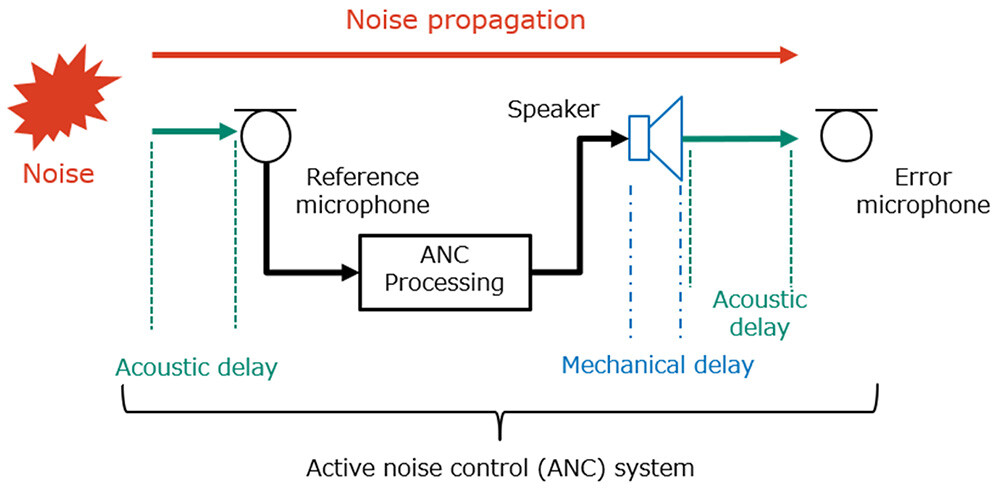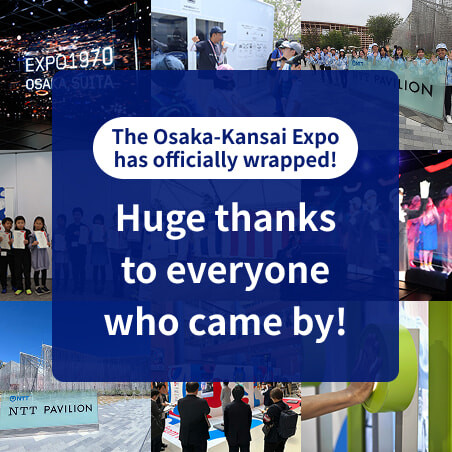Microsoft ends support for Internet Explorer on June 16, 2022.
We recommend using one of the browsers listed below.
- Microsoft Edge(Latest version)
- Mozilla Firefox(Latest version)
- Google Chrome(Latest version)
- Apple Safari(Latest version)
Please contact your browser provider for download and installation instructions.
November 14, 2024
NTT Corporation
World's first wideband noise-canceling technology for open-ear headphones that reduces ambient noise without blocking your ears
A comfortable and clear listening experience without blocking your ears, even in a crowded city and in mobility
News Highlights:
- Active Noise Control (ANC) technology was established to reduce noise over wideband frequencies up to 100 to 3,000 Hz so that sound from open-ear headphones can be heard clearly even under noisy conditions.
- To reduce the delay of the ANC system, which is necessary to realize wideband noise suppression, we have developed a new design for the microphone and speaker of the headphone body to reduce the acoustic delay, and a speaker design and software processing to reduce the mechanical delay of each frequency band.
- Open-ear headphones provide a comfortable listening experience even in noisy environments.
TOKYO - November 14, 2024 - NTT Corporation (Headquarters: Chiyoda Ward, Tokyo; Representative Member of the Board and President: Akira Shimada; hereinafter "NTT") has developed ANC technology for open-ear headphones that do not cover the ears, reducing ambient noise near the ears. As a practical noise-canceling technology for open-ear headphones, we have newly developed the microphone and speaker design of the headphone body and software processing to achieve wideband noise suppression. With this technology, you can hear the playback sound from open-ear headphones clearly by reducing noise while feeling the surrounding sound naturally. It is also expected that the use case of acoustic XR technology1, which combines virtual sound heard through headphones with real sound heard directly by the ear, will expand. Open-ear headphones utilizing this technology will be exhibited at NTT R&D FORUM 2024 IOWN INTEGRAL2 to be held in Tokyo from November 25-29, 2024.
Background
NTT has established PSZ (Personalized Sound Zone) technology, which is the ultimate private sound space in which "desired sounds" can be heard only by oneself without leaking to others, and "undesired sounds" can be reduced. NTT has been working on the development of design technology for open-ear headphones that realize playback that can only be heard by the user without blocking the ears3. These open-ear headphones allow users to listen to their surroundings naturally and are designed to prevent sound leakage, so they can be used in public places, offices and other shared spaces. In addition, it can be worn for a long time without tiring the ears. Focusing on these features, we have proposed an acoustic XR technology that integrates the virtual sound heard from open-ear headphones with the real sound heard directly by the ear, and are conducting R&D and demonstration tests1.
Conventional open-ear headphones can only reduce sound below 1,000 Hz, even if they have a noise-canceling feature. For this reason, it was not possible to reduce the sound around 3,000 Hz, which the human ear is most sensitive to, and there was a risk of hearing loss due to having to increase volume when surrounding noise was high. To address this issue, we have developed an active noise control ANC technology that can reduce noise above 1,000 Hz in open-ear headphones.
Technical challenge
There are two methods of noise reduction used in headphones: active noise control (ANC) and passive noise control (PNC). The ANC collects the noise with a reference microphone built into the headphones, and uses an error microphone to determine whether the noise is eliminated in the ear. The ANC generates an anti-phase signal of the noise and plays it back from the headphones to compensate for the noise. It can reduce low frequencies, especially those below 1,000 Hz. PNC, on the other hand, blocks noise by blocking the ear with the physical structure of the headphone itself. It can reduce noise, especially at high frequencies above 1,000 Hz. Closed-back headphones equipped with ANC, which are already widely used, achieve effective noise reduction by combining ANC and PNC.
Open-ear headphones, however, have no structure to block your ears, so high-frequency noise reaches your ears as it is. In addition, since human hearing characteristics are sensitive at around 3,000 Hz, to achieve effective audible noise reduction in open-ear headphones, it is necessary to use ANC technology to silence high frequencies above 1,000 Hz.
 Figure 1 Comparison of ANC Between Closed-Back Headphones and Open-Ear Headphones
Figure 1 Comparison of ANC Between Closed-Back Headphones and Open-Ear Headphones
Technical point
To reduce noise above 1,000 Hz using ANC technology, the ANC system must perform the processing from the noise captured by the reference microphone until the anti-phase of the noise reaches the position of the error microphone with very low delay (in sub-milliseconds). In the case of headphones, since the reference microphone, error microphone, and speakers for playing back the cancellation sound are built into the headphones themselves, the distance between them is approximately a few centimeters. Therefore, the ANC system must be very fast, so the delay of the ANC system must be as low as possible. Therefore, we have developed a technology to reduce the two delay factors:
(1) Acoustic delay
(2) Mechanical delay
(1) The acoustic delay in is the time difference between the sound source and the target location. Sound travels through air at a speed of about 340 meters per second, which is much slower than light or electrical signals. Therefore, we established a new design in which the microphones are positioned closer to the source of the noise and the reference microphones, as well as to the headphone speaker unit and the error microphones, to reduce acoustic delay. (2) The mechanical delay refers to the delay that occurs when the mechanical components inside the device or headphones move. For example, the diaphragm of the speaker unit in headphones takes a physical time between receiving an electrical signal and producing sound. The delay varies for each frequency band, depending on the design of the speaker unit. In this technology, the mechanical delay of each frequency band was reduced by new hardware design and software processing. In the hardware design, the position and characteristics of the loudspeaker were newly designed, and in the software processing, the filter design with low delay and low computation was performed. By combining this technology with the design technology for open-ear headphones3, which prevents sound leakage, the cancellation sound is not leaked to the surroundings and noise increases around the user.
This technology, which reduces acoustic and mechanical delays, enables the world's first wideband ANC in open-ear headphones. We evaluated this technology using aircraft noise and found that it reduced noise to around 3,000 Hz. Specifically, noise reduction of up to 13.7 dB and an average of 7.8dB is achieved at 1 - 3 kHz.
 Figure 2 Acoustic and Mechanical Delay in ANC
Figure 2 Acoustic and Mechanical Delay in ANC
 Figure 3 Prototype Open-Ear Headphones Designed Using This Technology
Figure 3 Prototype Open-Ear Headphones Designed Using This Technology
 Figure 4 Evaluation of Noise Suppression Performance in ANC Using This Technology
Figure 4 Evaluation of Noise Suppression Performance in ANC Using This Technology
Outlook
With the aim of commercializing open-ear headphones incorporating this technology in the future, we will study applications in real environments such as crowded streets and mobility. In addition, we will create new usage scenarios by integrating this technology with the Acoustic XR Technology, which combines virtual sound heard through headphones with real sound heard directly by the ear, and develop new audio experiences such as immersive entertainment and audio guides through NTT Group.
[Glossary]
1"Cho-Kabuki Powered by NTT" Challenges New Spatial Sound Production
https://group.ntt/jp/newsrelease/2023/04/29/230429b.html
2NTT R&D FORUM 2024 -IOWN INTEGRAL Official Website https://www.rd.ntt/e/forum/2024/

3Developed earphone design technology that only the user can hear without blocking the ear
https://group.ntt/en/newsrelease/2022/11/09/221109a.html
About NTT
NTT contributes to a sustainable society through the power of innovation. We are a leading global technology company providing services to consumers and businesses as a mobile operator, infrastructure, networks, applications, and consulting provider. Our offerings include digital business consulting, managed application services, workplace and cloud solutions, data center and edge computing, all supported by our deep global industry expertise. We are over $97B in revenue and 330,000 employees, with $3.6B in annual R&D investments. Our operations span across 80+ countries and regions, allowing us to serve clients in over 190 of them. We serve over 75% of Fortune Global 100 companies, thousands of other enterprise and government clients and millions of consumers.
Media contact
NTT Service Innovation Laboratory Group
Public Relations
ntt-pr@ntt.com
https://tools.group.ntt/en/rd/contact/index.php?param01=R¶m02=203
Information is current as of the date of issue of the individual press release.
Please be advised that information may be outdated after that point.
NTT STORY
WEB media that thinks about the future with NTT










